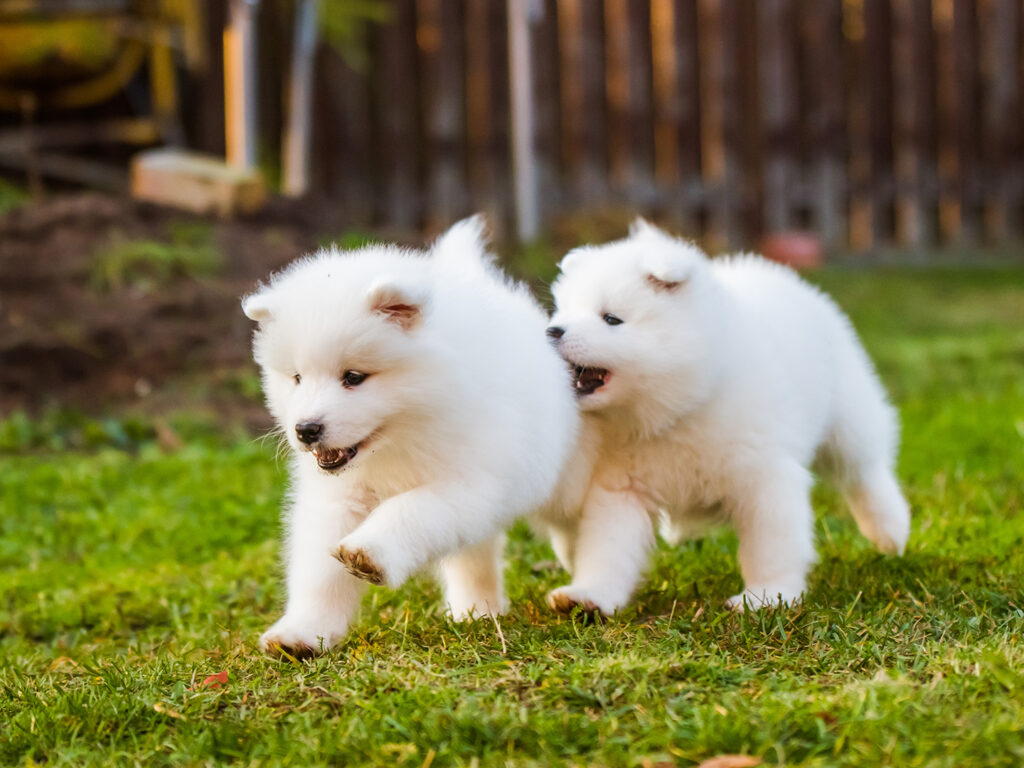The Puppy Timeline: A Socialization Guide

Socializing is important for raising puppies into emotionally healthy dogs, just as caring for a puppy’s growing needs is important to physical and mental health. In order to have a well-adjusted and social dog, owners should provide training specific to each stage of a puppy’s development.
Harmony Diers, a veterinary technician at the Texas A&M School of Veterinary Medicine & Biomedical Sciences, provides ways to socialize puppies during the five stages of growth.
In the neonatal stage, or the first two weeks of a puppy’s life, Diers suggests owners gently hold their puppies for short periods of time to begin the socialization process. When puppies hit the transitional stage, between 2-4 weeks of age, they begin to socialize on their own by playing with their littermates. Diers recommends owners continue to hold their puppies in the transitional phase to assist in their socialization.
One of the most important stages in developing a dog’s personality, according to Diers, is the socialization stage, which lasts between 3-12 weeks of age.
“Most of what puppies learn about socialization occurs in this stage,” Diers said. “Exposure to positive human interactions and new activities, situations, and experiences will help puppies gain confidence in their interactions with a variety of people, objects, sounds, and events.”
Examples of positive experiences include taking puppies on short car rides; introducing them to more toys and new objects, such as leashes and brushes; meeting new dogs and people; and exposing them to new environments.
“When meeting new dogs, it is important to ensure that the ‘new’ dog is friendly to avoid injuring the puppies; the new dog also should be vaccinated to avoid transmitting diseases or viruses,” Diers said. “In addition, when being exposed to new environments, unvaccinated puppies should avoid public settings, such as dog parks or pet supply stores, so that they are not susceptible to viruses and diseases. Instead, puppies can visit their own backyard or the house/yard of a friend or family member.”
During the socialization stage, puppies continue to play with their littermates and learn bite inhibition as well.
“Bite inhibition refers to a puppy learning how hard to bite their playmate based on the reaction they get from that playmate,” Diers explained. “As a puppy bites and wrestles with their littermates, the other puppy may yelp or recoil from the bite or play, indicating that the bite was too hard or the playing was too rough.”
Lastly, puppies become more aware of their relationship with humans in the beginning of the socialization stage, and by the end of the stage, their interest in bonding with humans increases.
The most challenging of developmental stages, however, is the juvenile stage, from 3-6 months of age.
“Puppies are learning their rank or position in their pack, so it will become more obvious which puppies are more outgoing and dominant or shy and submissive,” Diers said. “It is often this stage of development that determines the future behavior of a dog.”
Owners should be aware of certain behaviors — such as aggression over food and objects or fear of new stimuli — because puppies left to continue aggressive or fearful behaviors often grow into an adult with these behaviors, which can lead to a dog being rehomed or taken to a shelter.
“It is of vital importance for training and socialization to continue because puppies are very sensitive and receptive to behavior modifications during the juvenile stage, much more than an older puppy or adult dog,” Diers said.
Finally, Diers emphasizes that training young dogs is crucial in the last development stage — the adolescent stage, which occurs between 6-18 months of age — because they are more capable of learning commands and tricks than in earlier phases.
“By adolescence, a puppy has an increased attention span and more hormones that will increase energy,” Diers said. “Training your puppy to channel that energy appropriately can reduce unwanted behaviors. In addition, it is great mental stimulation and social behavior practice to teach your puppy to work for things (sit, stay, shake hands, lay down, etc.). For example, teaching them to sit and wait before doing an action will help them focus on their owner’s instruction, thus resulting in more polite behavior and a connection to their owner.”
Knowing how to socialize your furry friend throughout their time as a puppy can ensure that they adjust and become a happy and healthy lifelong member of your family.
Harmony Diers is a member of The Dog Aging Project. The Dog Aging Project at Texas A&M is working to understand how genes, lifestyle, and environment influence canine health and aging through research that asks pet owners to complete surveys about their dogs. To learn more, or to enroll your dog, visit https://dogagingproject.org.
Pet Talk is a service of the College of Veterinary Medicine & Biomedical Sciences, Texas A&M University. Stories can be viewed on the web at vetmed.tamu.edu/news/pet-talk. Suggestions for future topics may be directed to vmbs-editor@tamu.edu.


